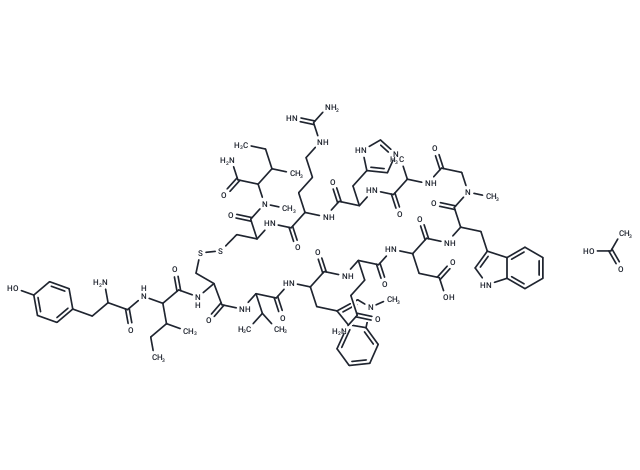Shopping Cart
Remove All Your shopping cart is currently empty
Your shopping cart is currently empty
AMY-101 acetate (Cp40 acetate) is a cyclic peptide, an inhibitor of C3 Complement and an immunomodulator used in the treatment of gingivitis and periodontitis, which significantly reduces inflammation and lowers MMP-8 and MMP-9 levels.AMY-101 acetate also have a palliative effect on covid -19-induced lung inflammation/injury and SARS-COV-2-related acute kidney injury in patients with acute respiratory distress syndrome (ARDS).

| Pack Size | Price | USA Warehouse | Global Warehouse | Quantity |
|---|---|---|---|---|
| 1 mg | $297 | In Stock | In Stock | |
| 5 mg | $753 | In Stock | In Stock | |
| 10 mg | $987 | In Stock | In Stock | |
| 25 mg | $1,530 | In Stock | In Stock | |
| 50 mg | $1,980 | In Stock | In Stock | |
| 100 mg | $2,780 | - | In Stock |
| Description | AMY-101 acetate (Cp40 acetate) is a cyclic peptide, an inhibitor of C3 Complement and an immunomodulator used in the treatment of gingivitis and periodontitis, which significantly reduces inflammation and lowers MMP-8 and MMP-9 levels.AMY-101 acetate also have a palliative effect on covid -19-induced lung inflammation/injury and SARS-COV-2-related acute kidney injury in patients with acute respiratory distress syndrome (ARDS). |
| In vitro | AMY-101 acetate (Cp40 acetate), a compstatin-based C3 inhibitor, effectively blocks complement activation in vitro by preventing the cleavage of C3 and downstream generation of inflammatory effectors[1]. |
| In vivo | In a severe COVID-19 patient, intravenous AMY-101 acetate (5 mg/kg/day for 14 days) was well tolerated and led to rapid improvement in inflammation and respiratory function, with no renal or hepatic toxicity observed[1]. In non-human primates with naturally occurring periodontitis, local administration of AMY-101 acetate (0.1 mg/site, every 3 weeks) effectively reduced periodontal inflammation without local irritation. Daily subcutaneous administration (4 mg/kg) provided systemic protection against periodontal tissue destruction[2]. |
| Synonyms | Cp40 acetate, Cp 40 acetate |
| Molecular Weight | 1849.14 |
| Formula | C85H121N23O20S2 |
| Smiles | CCC(C)C(C(=O)NC1CSSCC(NC(=O)C(NC(=O)C(NC(=O)C(NC(=O)CN(C(=O)C(NC(=O)C(NC(=O)C(NC(=O)C(NC(=O)C(NC1=O)C(C)C)CC2=CN(C3=CC=CC=C32)C)CCC(=O)N)CC(=O)O)CC4=CNC5=CC=CC=C54)C)C)CC6=CN=CN6)CCCNC(=N)N)C(=O)N(C)C(C(C)CC)C(=O)N)NC(=O)C(CC7=CC=C(C=C7)O)N.CC(=O)O |
| Sequence | {D-Tyr}-Ile-Cys-Val-{Trp(Me)}-Gln-Asp-Trp-{Sar}-Ala-His-Arg-Cys-{N(Me)Ile}-NH2 (Disulfide bridge:Cys3-Cys13) |
| Sequence Short | {D-Tyr}-ICV-{Trp(Me)}-QDW-{Sar}-AHRC-{N(Me)Ile}-NH2 (Disulfide bridge:Cys3-Cys13) |
| Storage | keep away from moisture,keep away from direct sunlight,store at low temperature | Powder: -20°C for 3 years | In solvent: -80°C for 1 year | Shipping with blue ice/Shipping at ambient temperature. |
| Size | Quantity | Unit Price | Amount | Operation |
|---|

Copyright © 2015-2025 TargetMol Chemicals Inc. All Rights Reserved.